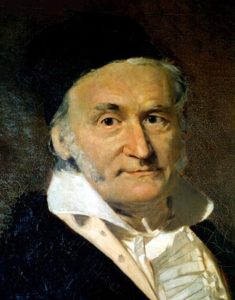Introduction to Gaussian Elimination
Learning Outcomes
By the end of this section, you will be able to:- Write the augmented matrix for a system of equations.
- Perform row operations on an augmented matrix.
- Use Gaussian elimination to solve a systems of equations represented as an augmented matrix.
- Interpret the solution to a system of equations represented as an augmented matrix.
 German mathematician Carl Friedrich Gauss (1777–1855).
German mathematician Carl Friedrich Gauss (1777–1855).Licenses & Attributions
CC licensed content, Original
- Revision and Adaptation. Provided by: Lumen Learning License: CC BY: Attribution.
CC licensed content, Shared previously
- College Algebra. Provided by: OpenStax Authored by: Abramson, Jay et al.. License: CC BY: Attribution. License terms: Download for free at http://cnx.org/contents/[email protected].
CC licensed content, Specific attribution
- Precalculus. Provided by: OpenStax Authored by: OpenStax College. Located at: https://cnx.org/contents/[email protected]:1/Preface. License: CC BY: Attribution.
